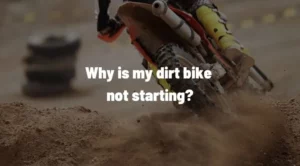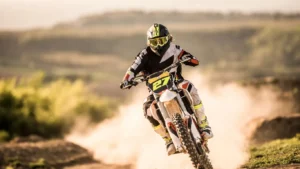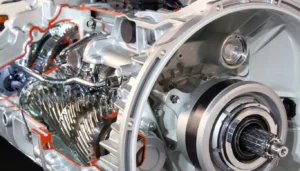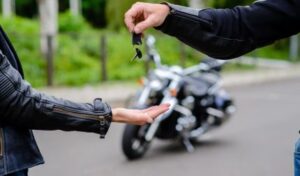Kickstarting a cold dirt bike is complicated. Due to its complexity and finesse, starting a cold dirt bike is considered an art. Kickstarting is explained in this introductory section. We’ll explain how to kickstart a cold dirt bike and why it’s important for riders.
This section discusses how to kickstart a cold dirt bike. This knowledge helps novice and experienced riders avoid bike damage and start each ride efficiently. Knowing how to kickstart a cold dirt bike can prevent riders from getting stuck in remote or dangerous places. Riders are encouraged to learn the kickstart process in this section.
What is A Dirt Bike?
Dirt bikes have unique features that set them apart from other motorcycles. This includes their lightweight design, off-road capabilities, and rugged terrain-specific features. Knowing how a dirt bike works helps you kickstart it in cold weather.
We’ll break down the dirt bike’s kickstart-relevant mechanical parts here. Engine, fuel, ignition, and kickstart systems will be examined. We’ll show how these parts work together to show the dirt bike’s mechanical harmony. This knowledge will help readers understand the kickstart process and troubleshoot issues.
This segment will explain why a dirt bike engine’s cold state makes kickstarting harder. Combustion and temperature will be discussed. Low temperature impacts lubrication, battery, and fuel system. This discussion will explain why cold weather requires a different approach to kickstarting a dirt bike.
Before the Kickstart: Preparations
Dirt Bike Maintenance: The Key to Reliable Kickstarting
Kickstarting a dirt bike in cold weather requires regular maintenance. Regular maintenance maintains the bike’s mechanical components for efficient kickstarting. Air filter, spark plug, and oil changes are included. Well-maintained bikes improve kickstarting.
Performing a Quick Safety Inspection: What to Look For
Readers will learn how to quickly but thoroughly inspect their dirt bike before starting it. This check ensures the bike starts. Tires, brakes, chain, and throttle will be checked. This step-by-step guide helps riders start their bikes quickly.
Necessity of Warming Up the Bike: An Analysis
Before starting in cold weather, warm up the bike. Warming up the bike primes the engine, prepares the fuel system, and softens the engine oil, as explained scientifically. We will also discuss dirt bike warming up for different conditions. This analysis shows why preparation is crucial.
Look at the Kickstart Process
Locating the Kickstart Lever: Your First Step
Find your dirt bike’s kickstart lever here. We’ll show lever placement by bike model with visuals. Lever handling will help kickstarting. Starting a dirt bike requires understanding the kickstart lever.
The Right Positioning: Mastering Body Placement
Body position affects kickstarting. Kickstarting a cold dirt bike requires proper body position. Standing, balancing, foot placement, and powerful kicks. Kickstarting requires body positioning.
Finding the Compression Point: An Essential Trick
Beginners often overlook the compression point, which is essential to dirt bike kickstarting. This section explains the compression point and its importance in kickstarting. We’ll also explain how to locate the compression point on various dirt bike models. This technique can help readers kickstart their dirt bike, especially in cold weather.
How to Kick Start a Cold Dirt Bike Step-by-Step
A simplified step-by-step guide to kickstarting a cold dirt bike:
1. Pre-Start Checks: Check your dirt bike before starting it. Check the fuel, tyres, and bike’s condition.
2.Turn on the Fuel: Turn on your bike’s fuel valve (petcock) to allow fuel to flow into the carburetor.
3. Set the Choke: Engage your bike’s choke. The choke enriches the fuel-air mixture to start a cold engine.
4. Find the Kickstarter: Open the kickstarter lever.
5. Position Yourself Correctly: Stand on the left side of the bike (if the kickstart lever is on the right) with one foot on the ground and the other on the kickstarter. To stabilise the bike, keep your hands on the handlebars and apply the front brake.
6. Find the Compression Point: Slowly press your foot on the kickstarter until you feel resistance. Compression point.
7. Perform the Kick: From the compression point, lift your foot slightly and kick the kickstarter hard. Kick through the stroke, not halfway.
8. Listen for Engine: If the bike starts, you’ll hear the engine.
9. Disengage the Choke: Disengage the choke after the bike starts and warms up.
10. What If It Doesn’t Start?: If It Doesn’t Start? Kickstart the bike several times if it doesn’t start. If it still won’t start, check the spark plug, fuel system, or battery.
Kickstarting a dirt bike, especially a cold one, takes practise and bike feel. Don’t give up. You’ll learn your bike’s starting procedure with practise.
Common Mistakes and How to Avoid Them
Overlooking Bike Maintenance: A Fatal Mistake
This section emphasises the dangers of neglecting bike maintenance and how it can slow kickstarting. Spark plugs, fuel lines, and air filters need regular maintenance. In cold weather, reliable kickstarting requires consistent maintenance.
Improper Body Positioning and Kickstart
Riders often misalign their bodies during kickstarting. This section discusses how such an error can damage or fail the kickstart process. We’ll cover kickstarting’s best body and foot positions. Readers will avoid body positioning-related failures and dangers.
Misunderstanding of the Compression Point
For a successful kickstart, dirt bike riders, especially beginners, often overlook or misunderstand the compression point. We’ll explain the compression point, its importance, and how to find it in this section. We will also discuss compression point mistakes and how to avoid them. This will help readers understand kickstarting and avoid failures.
Advanced Dirt Bike Kickstarting Tips
Kicking Perfectly: Timing and Power
This section covers how to kick a cold dirt bike with timing and power. We’ll talk about how to time a strong, fast kick with the compression cycle. We’ll teach you how to kick harder without straining or injuring yourself. Readers can maximise kickstarting effectiveness with these expert tips.
Cold Start Fuel and Choke
Fuel and choke are essential to starting a cold dirt bike. Knowing how to manipulate these components can boost cold start success. We’ll demonstrate how to prime fuel and use the choke in cold weather. Riders can reduce cold start time and frustration with this knowledge.
Dealing with Persistent Issues: When to Seek Professional Help
Riders can fix most kickstart issues, but sometimes they need help. This section discusses persistent problems that may indicate a deeper mechanical issue that requires a professional mechanic. We’ll explain major issues’ symptoms and how to get help. This will ensure readers can safely and effectively handle serious issues, preserving their dirt bike.
Conclusion
In this final section, we’ll discuss the joy of cold dirt bike kickstarting. We’ll recap the article and emphasise how this skill can improve dirt biking. Mastering this process shows a deeper understanding of one’s dirt bike, making riding more fulfilling and empowering.
Finally, we’ll talk about applying this article’s knowledge. Mastery requires practise and hands-on experience. We recommend using this guide to improve kickstarting skills. We’ll leave them with some motivation, emphasising that each rider’s journey is unique and the true victory is continuous learning and improvement.
Frequently Asked Questions
1. Why won’t my dirt bike start in the cold?
Due to engine and oil temperatures, starting a dirt bike in cold weather is harder. The carburetor may supply a leaner fuel mixture, making the engine harder to start.
2. How can I tell if my dirt bike is at the compression point?
Slowly pressing the kickstarter feels the compression point, or “hard spot.” Compression strokes make the kickstarter harder to push down.
3. What role does the choke play in starting a cold dirt bike?
The choke enriches the fuel-air mixture, making it easier to ignite a cold engine. Turn off the choke after the engine warms up.
4. How long should I warm up my dirt bike before starting it?
Before riding, let your dirt bike warm up for a few minutes, depending on the bike and temperature.
5. Why is proper body positioning important when kickstarting a dirt bike?
Kicking with force requires proper body positioning. Standing on the footpeg helps you kick hard and avoid injury.
6. When should I seek professional help if my dirt bike won’t start?
If your dirt bike won’t start after checking fuel, spark, and air, or if you don’t feel comfortable troubleshooting, call a mechanic.
7. Can a worn-out part affect the bike’s ability to kickstart?
Yes, worn parts can affect a dirt bike’s start. The spark plug, kickstarter, carburetor, and other parts can affect starting if they’re not working properly. Regular inspections and maintenance can detect and replace worn parts before they fail.





